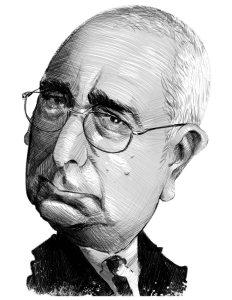MAE SOT, THAILAND — Although we often read about Aung Sang Suu Kyi’s fight for democracy in Rangoon, a far bloodier struggle is being carried out in the jungles east of the Dawna mountain range. The brutal Burmese junta, known as the State and Peace Development Council (SPDC), has launched its biggest military offensive in a decade. The human casualties of the conflict are pushed throughout the border region. Many victims of past military actions have ended up in sprawling refugee camps near Mae sot, a small, rural community just over the Thai border.
The SPDC long has been warring against the Karen, Karenni, and other ethnic groups. From a distance the individual victims blur into an indistinguishable mass. Talking to children caught in the violence helps brings the tragedy into clearer focus.
The group Christian Freedom International supports medical clinics, schools, and orphanages in Burmese villages and Thai refugee camps. One of its newest efforts is a small school in Thailand, located about a mile from the border, which serves 31 kids from nearby camps.
The children’s ages range from 11 to 17. Squeals of joy and raucous laughter drifted throughout the building one recent day as they played a form of tag in the common room upstairs.
Yet happiness has been a scarce commodity for many of them. These are not the lives of secure American teenagers, with cell phones, cars, stereos, and tickets to college. Most of these kids have endured far more hardship than the rest of us will see in our lifetimes.
Many of the children have lost at least one parent to war. Most have seen homes and villages ravaged by Burmese military forces.
Several were born in refugee camps. Sickness and death are common. Families often have broken apart, with children distributed among relatives. Almost all have been forced to move, often multiple times.
The experience of 14-year-old Klo P’lan Paw, nick-named Gloria, is distressingly common. She explains: “Sometimes Burmese soldiers come to our village. They also burn our house, destroy our garden and when they ask someone to give them a thing they need when we did not give them they kill our people so every time we afraid and always we have a danger. When they need a person to help them and carry heavy thing for them they came to our village and call a man to go carry things for them.”
One of the more chilling stories is told by 15-year-old Moo Nay Paw (Andrea):
“We met the Burmese soldiers in the distance. We couldn’t run, because they surrounded us. They arrested us and tied all the men. My mother and I went to stay under a big tree to take a short rest. At the moment one man tried to escape and ran behind me and my ma. While he ran, the Burmese army shot him. At that time I saw my mother lay down beside me, because one of the bullets came through my ma, but I didn’t know my ma died. I called her ‘Mother…mother’ and I tried to move her. I called her again and again, but there was no reply.”
A couple years later her father met a similar fate. She says: “He was killed when he came back to his village. Before he was killed, he was beaten like people beat animals. When I received this message I cried.”
Htoo Lar Paw, nick-named Mary, is 14. When she was four her mother died of TB. Then, relates Htoo Lar Paw, “When I was ten years old my father died, because my village is not near the hospital. Also my family do not have enough money to go to buy medicine. After my father died no one help us to send us to school. We become orphans. We can’t feed ourselves.”
She and her four siblings faced another challenge: “Because we do not have parents and always we need to run to the forest, we can’t stay in our village. Because the Burmese soldiers attacked our village and burn our village and take everything that they had saw. So we moved to refugee camp to save our life.”
Min Lay, or Paul, is 15. His village was under the SPDC’s control: “the farmers they give tax for Burmese government and some people had no land to feed their families. Sometimes they had to carry things when Burmese soldiers told them to.” His parents eventually sent Paul and his younger brother to live with their grandparents in a refugee camp in Thailand.
Brownika (Jill), recently turned 14. SPDC soldiers regularly came to her village, arresting some people, killing others, and impressing a number to be porters. Her parents fled to Thailand when her mother was pregnant: “When my family left the village to go to the refugee camp in Mae Hong Son, there were many difficulties along the way.” Her father became a soldier, but returned when her mother grew sick (and eventually died).
Pee Law, or Esther, is 15 and from the Burmese village of Taw Kah Koh. “Sometimes the Burmese soldiers came to my village, and we need to run.” They “captured the animals and ate them,” a devastating blow to the poor farmers. “When I heard the sound of guns, and I was very afraid,” she writes.
Sixteen-year-old Ky Moo, or Christopher, explains: “My family enjoy very much my village, but when Burmese soldiers came to village and they killed people and burn our village.” His family fled to a refugee camp in Thailand, but it was later attacked by a breakaway Karen group allied with the SPDC. Refugees were killed and wounded and his new home was burned down, so they fled again, to another camp.
Su Meh (Eve), 14, is one of eight children. She talks about her life: “When I was baby the Burmese soldiers come to kill us and we will run far away to another places. If we not run we will die.” But fleeing exacts a cost: “We do not have food to eat and we do not have money or clothes for us to wear.” A refugee camp was their best hope.
Khu Wak Paw, or Ruth, is 16. She was born in a Karen village in Thailand, but her father planted his land in Burma. “My father go to work with his friends over the border line. SPDC saw my father and they kill my father with one friend of my father.”
The family’s problems were not over. Although they were unsafe in Burma, “because we are not Thai citizens” the Thai police came and “exile us,” as well as other families, over the border. Their new village was vulnerable to SPDC soldiers, who “take the chicken and kill the pig also and sometimes kill the people.”
She would grow sad because “Karen people is like animals in the jungle.” Those who live in “the Karen village is always worry about the mines for the village it is difficult to feed their families. Most of Karen villagers cannot walk far away from the path because they afraid the mine will blow them up.” She eventually made it to Mae la refugee camp in Thailand, and thence to the CFI school.
Fifteen-year-old Lay Say, or John, saw his village burned down, so his family fled to Thailand. Both his father and uncle were soldiers with the Karen National Liberation Army. That’s “why the Burmese soldier come and kill my father.”
Way Nay Lin (Mark) also is 15. He tells his story: “Burmese soldiers attacked my village. Many people fled to the forest. The Burmese soldiers are too bad for us because they killed a lot of people and burn our home and our barn and they take away our animals and all things that they want. And in a few weeks they caught my father and beat, kicked and tied him up. The Burmese soldiers then took him to jail. And my father was there for a week before the soldiers tortured and killed him.”
Understandably, “my family was afraid” and “we fled into the jungle. During that time we had no food.” They eventually crossed the border into Thailand.
Fourteen-year-old Mercy Htoo, or Victoria, was born in a refugee camp. Before that her family lived in Burma, but fled after SPDC attacks on her village. She explains: “They want to went back to their own village, but they thought. If we go, the Burmese soldiers will see us and kill us. So they are very sad to leave their own country and their parents and all their relatives.”
The camp offered safety, but not opportunity. Explains Mercy Htoo: “they can’t go any where. They can’t own the land to plant the food, fruits, or vegetables.” Her family, she adds, “don’t want to stay in the refugee camp always because it’s not our own land and life is very difficult.”
Moo Ywee (Kimberly), is 14. Her story is simple but brutal: “Our family village have many dangers. Sometimes the Burmese soldiers attacked our village. We ran away, but some people did not escape. The soldiers shot and killed them.” Among the dead: her father. “When I am a child, I did not understand” why they murdered him. Her family made its way to a refugee camp in Thailand.
Although the brutality is universal, Christians, who encompass the vast majority of Karen and many Karenni, often are special targets. Klo P’lan Paw explains that “The Burmese soldier don’t like the Christian when they know, and see a Christian they kill all. So we need to worship in hide place.”
Paw Lah May, also known as Linda, is 13. Her village was attacked and burned. Her parents sent her to live with her aunt in a Thai refugee camp. She says that “The Burmese soldiers don’t like the Christian. If they see you worship God they kill you.”
What do the children want? Essentially what the rest of us want. Explains Khu Wah Paw: “Karen living in Burma “don’t have enough food, clothes and opportunity. Some of the children, if they want to learn, read, write, they don’t have anybody to teach them. We want our own land but we can’t have, we want freedom, we wait for many years but we never get.”
What can be done? The Burmese junta has proved to be impervious to international sanctions and pressure. Private aid can at least alleviate the human suffering. CFI’s Mae sot school is an example.
The children’s appreciation shines through their accounts of their lives. Moo Nay Paw says that “I thank God so much that he has given me a good opportunity and good people who help me and support me. I don’t have my parents on this earth, but I have a good parent and a good family in spirit who help me, teach me and take care of me.”
Fourteen-year-old Say Reh, or Roger, says: “I thanks the people in America who help my people in refugee camps. May God bless you America!”
Finally, several of the children ask for prayer. Paw Lah May implores: “PLEASE remember to pray for Karen people.”
No one, let alone a child, should have to go through what these kids have suffered. The Rangoon regime certainly is evil even if it is not a member of the axis of evil. Alas, there is little the West can do for the targets of the SPDC’s depredations, other than care for those who make it across the border — especially the youngest victims of a war that never seems to end.




